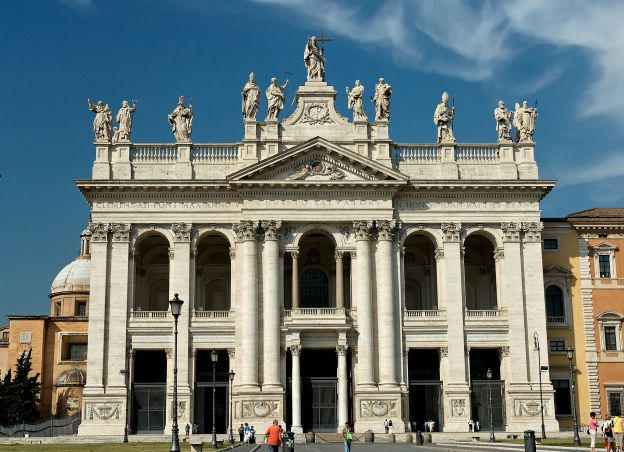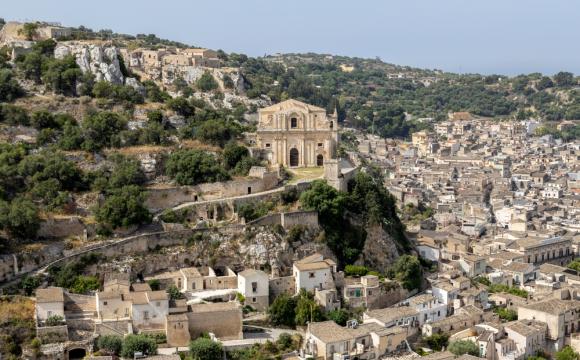As Rome prepares to host a special Jubilee Year, announced by Pope Francis last March and set to begin on December 8, let’s look at Rome’s four papal basilicas.
San Giovanni in Laterano (Papal Archbasilica of St. John in the Lateran)

Mater et caput of all Rome’s and the world’s Catholic churches, San Giovanni in Laterano is the oldest church of the Western World, founded in the 4th century by Constantine the Great. Dedicated to John the Baptist and John the Evangelist, it stands on the piazza by the same name, within Rome’s city center. San Giovanni in Laterano is also the city’s cathedral.
The basilica was reconstructed a few times until the 18th century, when the monumental façade, a two-storied portico supported by giant columns, crowned by 15 seven-meter-high statues, was redesigned. The solemn interior features a five-aisle nave, remodeled by Francesco Borromini in the 17th century, who also created the niches that would house the 12 colossal statues depicting the apostles. The graceful 14th century baldacchino over the high altar, which only the Pope can use, is surmounted by a reliquary said to contain the heads of Saints Peter and Paul. The Altar of the Holy Sacrament contains a cedar table said to be the one used by Christ during the Last Supper. A masterpiece of Cosmatesque art is the cloister.
Near the basilica, you can find the Scala Sancta, or Holy Stairs: white marble steps encased in wooden ones, which, according to Catholic tradition, once led to the praetorium of Pontius Pilate in Jerusalem on which Jesus Christ stepped on his way to trial during the events known as the Passion.
San Pietro in Vaticano (St. Peter’s Basilica)

At 22,067 square meters, St. Peter’s is the world’s largest church; regarded as one of the holiest Catholic shrines, it is a popular place of pilgrimage, even though it is neither the Mother Church nor a cathedral (San Giovanni in Laterano is both, as explained above).
It is hard to grasp its proportions until you have seen it. Particularly impressive is its height, 136 meters from the ground to the top of the magnificent dome, the tallest in the world.
According to Catholic tradition, the Basilica is the burial site of the apostle St. Peter, the first Pope and Bishop of Rome. St. Peter's tomb is said to be below the high altar. Many popes have been buried here since the Early Christian period.
A church has been on this site since Roman Emperor Constantine the Great. Construction of the present basilica, which replaced the basilica of the 4th century, began on 18 April 1506 and was completed in 1626.
St. Peter’s Basilica is also famous as a magnificent work of art, to which major Renaissance artists, including Michelangelo, Bramante, Raffaello, Sangallo and Giacomo della Porta contributed. Gian Lorenzo Bernini designed the ample staircase and elliptical square surrounded by columns, which “introduces” the basilica, with the façade by Carlo Maderno.
Inside, there’s no end to the number of incredible works of art, including the altar with Bernini’s baldacchino and Michelangelo’s Pietà.
San Paolo Fuori Le Mura (Papal Basilica of St. Paul Outside the Walls)

San Paolo Fuori Le Mura is the second largest basilica of the four. It was founded by the Roman emperor Constantine I over the burial place of St. Paul (now under the papal altar), making it a popular pilgrimage site. It is located on the Via Ostiense, near the left bank of the Tiber river, 2 kilometers outside the Aurelian Walls (hence its name).
The huge basilica has maintained the original structure with one nave and four aisles, but it was almost entirely reconstructed in 1823 following a fire. The covered portico that precedes the façade is a Neo-classicist addition from the reconstruction. To the right of the entrance is the Holy Door, which is opened only during the Jubilees (same for all four papal basilicas). What remains of the ancient basilica is the interior portion of the apse with the triumphal arch.
The nave's interior walls are decorated with scenes from Saint Paul's life. Notable works of art inside include the 13th century tabernacle by Arnolfo di Cambio, the statue of Pope Boniface IX and the 5th century mosaics on the triumphal arch. South of the transept is the cloister, considered one of the most beautiful of the Middle Ages, built by Vassalletto, who was also responsible for the magnificent Easter candlestick.
Santa Maria Maggiore (Basilica of St. Mary Major)

The largest church in Rome dedicated to the Virgin Mary, hence the name, and one of the first to be built in her honor, Santa Maria Maggiore is located on Piazza Esquilino, not far from the Termini train station. It is the only basilica among these four to have preserved the Paleochristian structure of the 5th century, even though it underwent several makeovers and additions externally.
It closely resembles a 2nd-century imperial basilica, imposing in its aspect, perhaps to signify Rome’s Christian future. The 14th century campanile (bell tower) is the highest in Rome, at 75 meters. The 16th-century coffered ceiling, designed by Giuliano da Sangallo, is said to be gilded with gold brought by Christopher Columbus from the Americas, and presented to Pope Alexander VI by Catholic monarchs Ferdinand and Isabella.
The most notable piece of art are the mosaics, one of the oldest representations of the Virgin Mary in Christian Late Antiquity, and a magnificent example of late Antique art. The triumphal arch is also illustrated with magnificent mosaics depicting different scenes of Christ and the Virgin Mary.
Under the high altar is the Crypt of the Nativity, with a crystal reliquary said to contain wood from Jesus’ crib. Notable are also the Sistine and Paoline chapels, the former adorned with statues by Arnolfo di Cambio, and both containing popes’ tombs.
Have you visited all four Basilicas? If not, you can take a virtual tour here.













